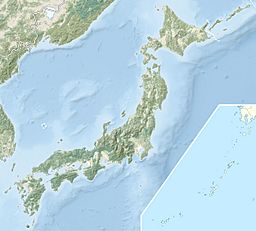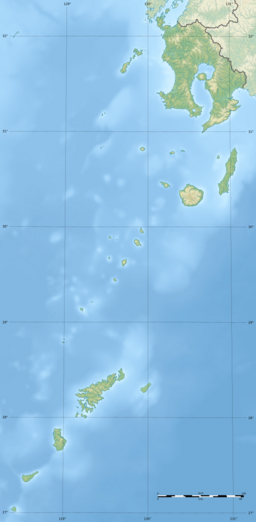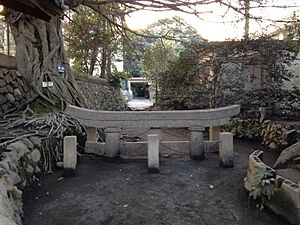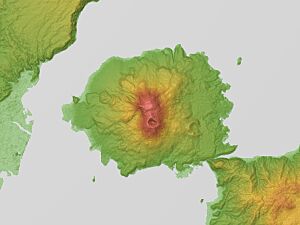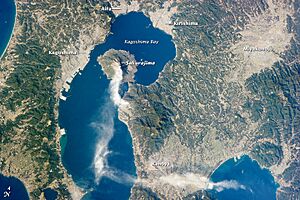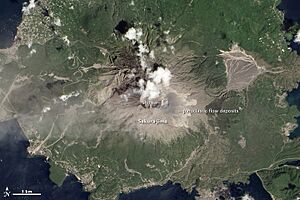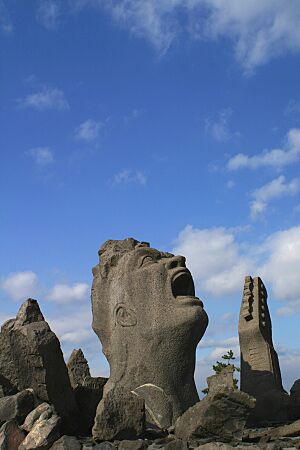Sakurajima facts for kids
Quick facts for kids Sakurajima |
|
|---|---|
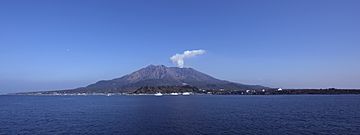
View of Sakurajima from mainland Kagoshima, 2009
|
|
| Highest point | |
| Elevation | 1,117 m (3,665 ft) |
| Prominence | 1,093 m (3,586 ft) |
| Listing | Ribu |
| Geography | |
| Geology | |
| Mountain type | Somma-stratovolcano |
| Last eruption | October 18, 2024 (ongoing) |
Sakurajima (Japanese: 桜島, meaning Cherry Blossom Island) is a very active stratovolcano in Kagoshima Prefecture, Japan. It used to be an island, but a huge lava flow in 1914 connected it to the Ōsumi Peninsula. It is known as the most active volcano in Japan.
As of April 2021, Sakurajima is still erupting. It often drops volcanic ash on the areas around it. Past eruptions helped create the white sand highlands in the region. In September 2016, experts thought the volcano might have a major eruption within 30 years. Since then, two large eruptions have happened.
Sakurajima is a stratovolcano, which means it's a tall, cone-shaped volcano built up by many layers of hardened lava and ash. Its top has three peaks: Kita-dake (northern peak), Naka-dake (central peak), and Minami-dake (southern peak). Minami-dake is the one that is active now.
Kita-dake is the highest point of Sakurajima, reaching 1,117 meters (about 3,665 feet) above sea level. The volcano is located in a part of Kagoshima Bay called Kinkō-wan. The area that used to be an island is now part of the city of Kagoshima, which is only 4 kilometers (about 2.5 miles) across the bay. The surface of this volcanic peninsula covers about 77 square kilometers (about 30 square miles).
A few thousand people live on Sakurajima. It used to be its own town and has schools, shrines, and shops. A ferry called the Sakurajima Ferry runs all day and night, connecting it to the mainland. Sakurajima is a popular place for tourists. People visit for its hot springs (called onsen), special pottery made from volcanic ash, and unique crops. These crops include the huge Sakurajima daikon radish and the sweet Sakurajima komikan orange, which grow well in the very rich volcanic soil.
Sakurajima also has many natural areas. Scientists study the different ecosystems that grow back after recent eruptions. This helps them understand how nature recovers, a process called ecological succession.
Contents
History of Sakurajima
How Sakurajima Formed
Sakurajima sits inside a large, 25-kilometer (15-mile) wide bowl-shaped area called the Aira caldera. This caldera formed about 22,000 years ago from a massive eruption. During that eruption, hundreds of cubic kilometers of ash and pumice exploded out. This caused the ground above the magma chamber to collapse, creating the huge caldera. Volcanic ash from this event fell as far as 1,000 kilometers (about 620 miles) away. Sakurajima is a newer, active part of this same ancient Aira caldera volcano.
Sakurajima itself began to form about 13,000 years ago from later volcanic activity inside the caldera. It is about 8 kilometers (5 miles) south of the caldera's center. The first time Sakurajima erupted that we know of was in 963 AD. Most of its eruptions are Strombolian, which means they are small, gentle explosions that mostly affect the top of the volcano. However, much larger eruptions, called Plinian eruptions, happened in 1471–1476, 1779–1782, and 1914.
Volcanic activity at the Kita-dake peak stopped around 4,900 years ago. Since then, eruptions have been centered on Minami-dake. Since 2006, most of the activity has been from the Showa crater, which is east of the Minami-dake peak.
The Big 1914 Eruption
| Type | Peléan |
|---|---|
| VEI | 4 |
| Impact | Pre-eruption earthquakes killed at least 35 people and an additional 23 people died; caused an evacuation and significant changes to the local topography. |
The 1914 eruption started on January 11 and was the strongest in Japan during the 1900s. The volcano had been quiet for over 100 years before 1914. Luckily, almost everyone living on the island had already left in the days before the eruption. Several strong earthquakes had warned them that an eruption was coming.
At first, the eruption was very explosive. It sent huge columns of ash into the sky and created fast-moving flows of hot gas and rock called pyroclastic flows. But after a very strong earthquake on January 12, and another one the next day, the eruption changed. It became less explosive and started producing a large lava flow. The earthquake on January 12 killed 35 people, and in total, 58 people died. The lava flows filled the narrow water channel between the island and the mainland, turning Sakurajima into a peninsula.
Lava flows are not common in Japan because the magma there is usually thick and sticky, leading to explosive eruptions. However, the lava flows at Sakurajima continued for many months. The island grew bigger, covering several smaller islands nearby. It eventually connected to the mainland with a narrow strip of land. Parts of Kagoshima Bay also became much shallower, which made the tides higher.
During the last part of the eruption, the magma chamber under the Aira Caldera emptied. This caused the center of the caldera to sink by about 60 centimeters (about 2 feet). This showed that Sakurajima gets its magma from the same source that caused the ancient caldera-forming eruption.
Recent Volcanic Activity
Sakurajima became much more active in 1955 and has been erupting almost constantly since then. Thousands of small explosions happen every year. These explosions throw ash several kilometers (a few miles) into the air. The Sakurajima Volcano Observatory was built in 1960 to watch these eruptions closely.
Monitoring the volcano and predicting big eruptions is very important. This is because the city of Kagoshima, with 680,000 people, is only a few kilometers (a few miles) away. The city regularly practices evacuation drills, and special shelters have been built where people can go if volcanic debris starts falling.
Because of the dangers it poses to nearby towns, Sakurajima was named a Decade Volcano in 1991. This means it was chosen for special study as part of the United Nations' plan to reduce natural disasters.
Sakurajima is part of the Kirishima-Yaku National Park. Its lava flows are a big attraction for tourists. The area around Sakurajima also has several hot spring resorts. One of the main farm products from Sakurajima is a huge, basketball-sized white radish called Sakurajima daikon.
On March 10, 2009, Sakurajima erupted, sending rocks and ash up to 2 kilometers (1.2 miles) away. This eruption was expected after several smaller explosions that weekend. No damage was reported.
Another eruption happened from the Minami-dake summit crater on Sunday, August 9, 2010, at 5:38 AM. It sent debris up to 5,000 meters (16,000 feet) high.
In 2011 and 2012, Sakurajima had several important eruptions. Volcanic activity continued into 2013.
On August 18, 2013, the volcano erupted from the Showa crater. It produced its highest ash plume since 2006, rising 5,000 meters (16,000 feet) high. This caused darkness and a lot of ash to fall on the central part of Kagoshima city. This eruption happened at 4:31 PM and was the 500th eruption of that year.
In August 2015, Japan's weather agency issued a Level 4 emergency warning. This urged people living nearby to get ready to evacuate. Scientists warned that a major eruption could happen soon. It did erupt around 8:00 PM on February 5, 2016.
After a long quiet period at one vent, eruptions suddenly stopped there and returned to the Showa crater on April 4, 2016. This happened about 8–9 days before major earthquakes near Kumamoto, Japan. Then, three months later, on July 26, it shot volcanic ash 5,000 meters (16,000 feet) into the air.
On October 3, 2020, at 7:35 AM UTC, the volcano erupted again, this time from the Aira caldera. An alert for airplanes was sent out, showing the ash cloud was still and reached 10,000 feet high.
On July 24, 2022, at 8:05 PM JST, a powerful eruption happened at the volcano's summit crater. Hot rocks scattered up to 2.5 kilometers (1.5 miles) from the crater. After this, at 8:50 PM JST, the Japan Meteorological Agency raised the eruption alert level from Level 3 to Level 5. Level 5 is the highest level, and it urged people to be very careful and evacuate. This was the first time a Level 5 alert was given for Sakurajima.
On February 9, 2023, an eruption happened at the Showa crater on Sakurajima at 10:52 AM JST. The plumes of ash rose to 1,000 meters (3,280 feet) by 11:10 AM JST. People within 2 kilometers (1.2 miles) were warned about pyroclastic flows (fast-moving hot gas and ash) and falling rocks.
On February 14, 2024, an eruption occurred at the Minamidake crater on Sakurajima at 6:33 PM JST. It sent plumes of ash over five kilometers (3.1 miles) high and threw rocks as far as 1.3 kilometers (0.8 miles) away.
Timeline of Sakurajima Eruptions
-
A print of Sakurajima by Hiroshige
Sakurajima in Culture
Sakurajima is the name of a short story written in 1946 by Japanese writer Haruo Umezaki. The story is about a Navy officer stationed on the volcano island near the end of World War II. It is based on Umezaki's own experiences.
Sakurajima was also the title of a song by Japanese singer Tsuyoshi Nagabuchi. In 2004, Nagabuchi held a huge all-night concert at a quarry on Sakurajima. About 75,000 people came to watch. After the concert, a statue of Nagabuchi singing with a guitar was placed at the concert site.
See also
 In Spanish: Sakurajima para niños
In Spanish: Sakurajima para niños
- List of volcanoes in Japan


